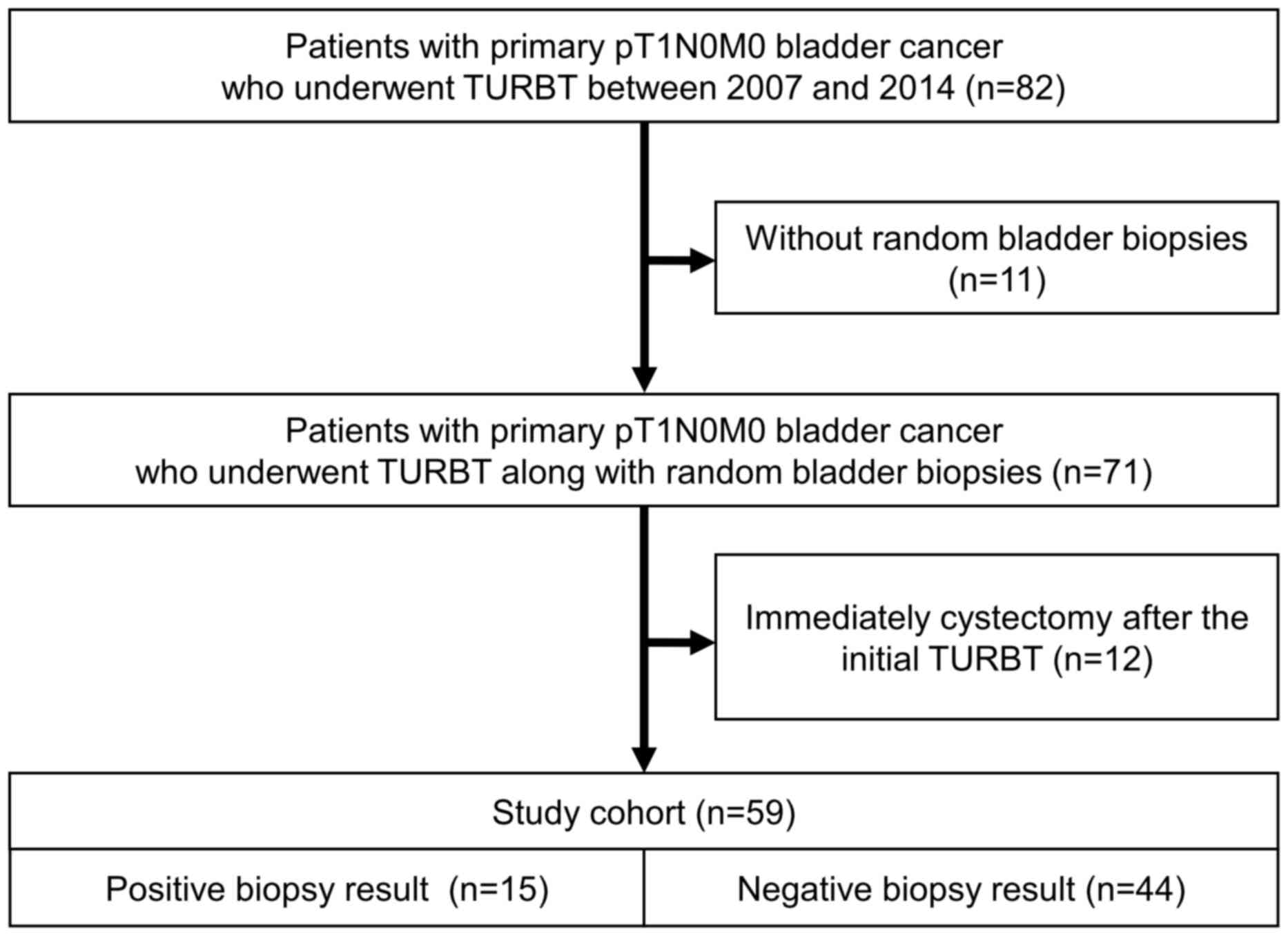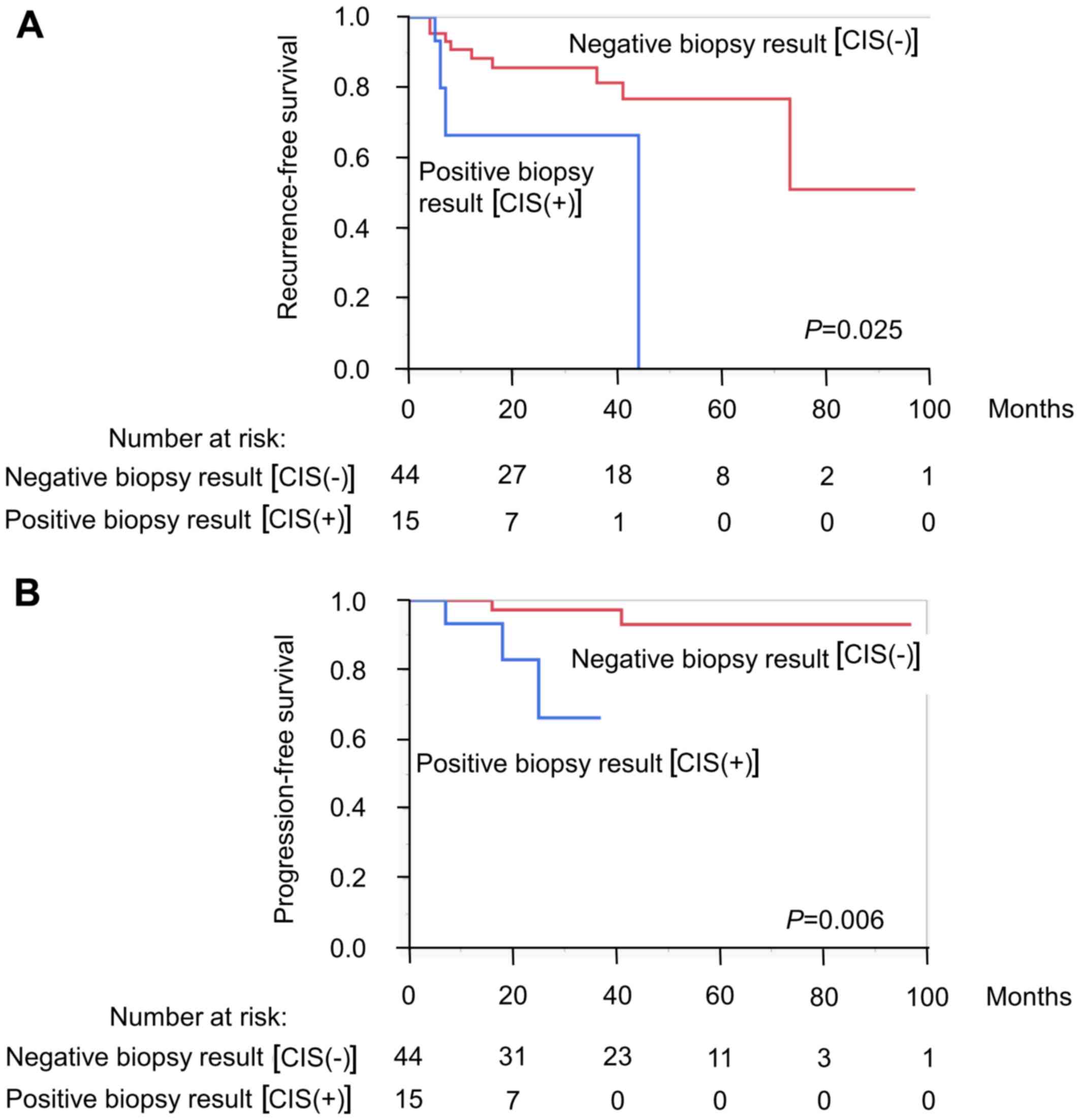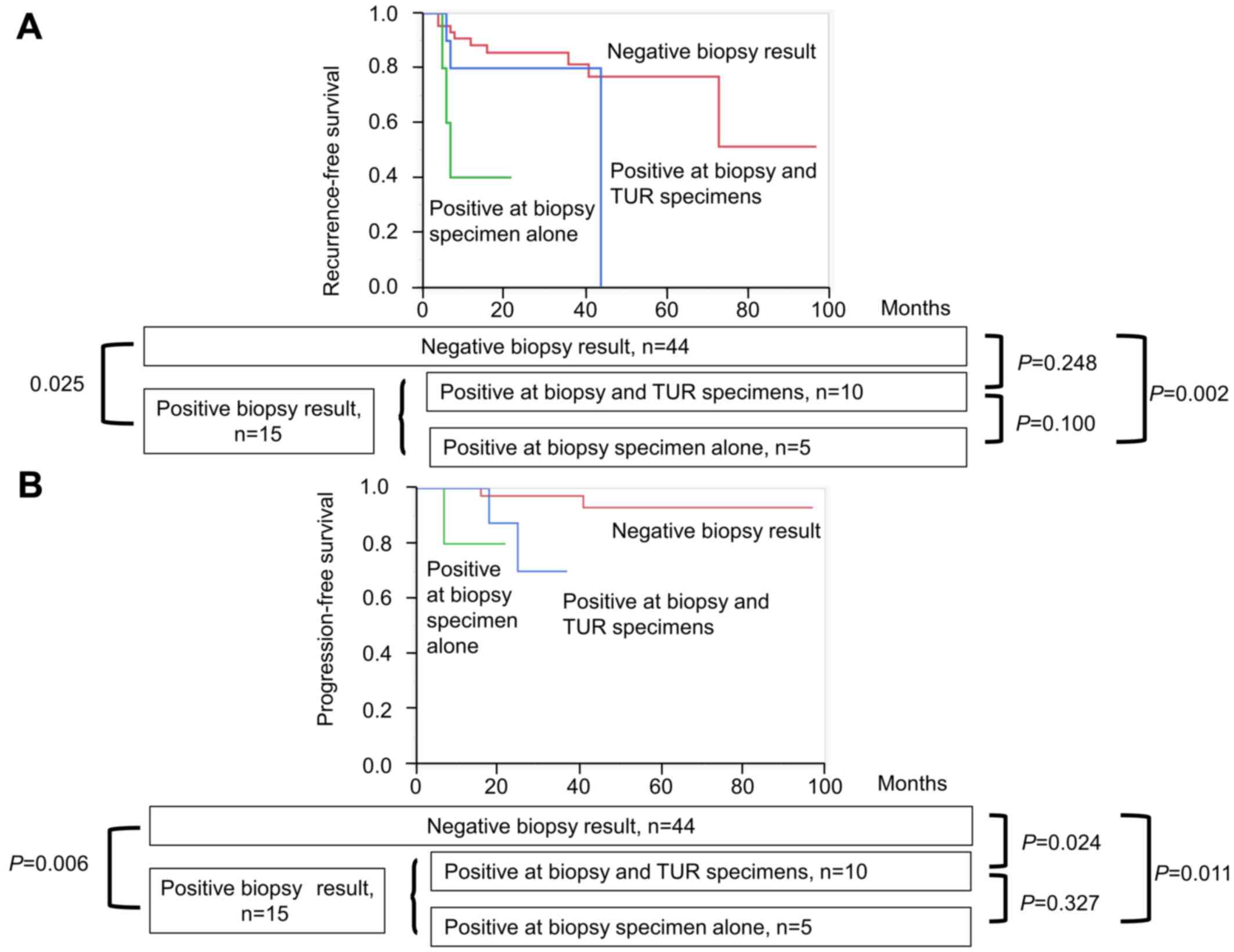|
1
|
Ferlay J, Shin HR, Bray F, Forman D,
Mathers C and Parkin DM: Estimates of worldwide burden of cancer in
2008: GLOBOCAN 2008. Int J Cancer. 127:2893–2917. 2010. View Article : Google Scholar : PubMed/NCBI
|
|
2
|
Burger M, Catto JW, Dalbagni G, Grossman
HB, Herr H, Karakiewicz P, Kassouf W, Kiemeney LA, La Vecchia C,
Shariat S and Lotan Y: Epidemiology and risk factors of urothelial
bladder cancer. Eur Urol. 63:234–241. 2013. View Article : Google Scholar : PubMed/NCBI
|
|
3
|
Steinmaus C, Ferreccio C, Acevedo J, Yuan
Y, Liaw J, Durán V, Cuevas S, García J, Meza R, Valdés R, et al:
Increased lung and bladder cancer incidence in adults after in
utero and early-life arsenic exposure. Cancer Epidemiol Biomarkers
Prev. 23:1529–1538. 2014. View Article : Google Scholar : PubMed/NCBI
|
|
4
|
Van Rhijn BW, Burger M, Lotan Y, Solsona
E, Stief CG, Sylvester RJ, Witjes JA and Zlotta AR: Recurrence and
progression of disease in non-muscle invasive bladder cancer: From
epidemiology to treatment strategy. Eur Urol. 56:430–442. 2009.
View Article : Google Scholar : PubMed/NCBI
|
|
5
|
Babjuk M, Burger M, Zigeuner R, Shariat
SF, van Rhijn BW, Compérat E, Sylvester RJ, Kaasinen E, Böhle A,
Redorta Palou J, et al: EAU guidelines on non-muscle-invasive
urothelial carcinoma of the bladder: update 2013. Eur Urol.
64:639–653. 2013. View Article : Google Scholar : PubMed/NCBI
|
|
6
|
Moch H, Cubilla AL, Humphrey PA, Reuter VE
and Ulbright TM: The 2016 WHO Classification of Tumours of the
urinary system and male genital organs-part A: Renal, penile, and
testicular tumours. Eur Urol. 70:93–105. 2016. View Article : Google Scholar : PubMed/NCBI
|
|
7
|
Soloway MS and Masters S: Urothelial
susceptibility to tumor cell implantation. Influence of
cauterization. Cancer. 46:1158–1163. 1980. View Article : Google Scholar : PubMed/NCBI
|
|
8
|
Fradet Y, Grossman HB, Gomella L, Lerner
S, Cookson M, Albala D and Droller MJ: PC B302/01 Study Group: PC
B302/01 study group. A comparison of hexaminolevulinate
fluorescence cystoscopy and white light cystoscopy for the
detection of carcinoma in situ in patients with bladder cancer: A
phase III, multicenter study. J Urol. 178:68–73. 2007. View Article : Google Scholar : PubMed/NCBI
|
|
9
|
May F, Treiber U, Hartung R and Schwaibold
H: Significance of random bladder biopsies in superficial bladder
cancer. Eur Urol. 44:47–50. 2003. View Article : Google Scholar : PubMed/NCBI
|
|
10
|
Taguchi I, Gohji K, Hara I, Gotoh A,
Yamada Y, Yamanaka K, Okada H, Arakawa S and Kamidono S: Clinical
evaluation of random biopsy of urinary bladder in patients with
superficial bladder cancer. Int J Urol. 5:30–34. 1998. View Article : Google Scholar : PubMed/NCBI
|
|
11
|
Fujimoto N, Harada S, Terado M, Sato H and
Matsumoto T: Multiple biopsies of normal-looking urothelium in
patients with superficial bladder cancer: Are they necessary? Int J
Urol. 10:631–635. 2003. View Article : Google Scholar : PubMed/NCBI
|
|
12
|
Hara T, Takahashi M, Gondo T, Nagao K,
Ohmi C, Sakano S, Naito K and Matsuyama H: Risk of concomitant
carcinoma in situ determining biopsy candidates among primary
non-muscle-invasive bladder cancer patients: Retrospective analysis
of 173 Japanese cases. Int J Urol. 16:293–298. 2009. View Article : Google Scholar : PubMed/NCBI
|
|
13
|
Denzinger S, Otto W, Fritsche HM, Roessler
W, Wieland WF, Hartmann A and Burger M: Bladder sparing approach
for initial T1G3 bladder cancer: Do multifocality, size of tumor or
concomitant carcinoma in situ matter? A long-term analysis of 132
patients. Int J Urol. 14:995–999. 2007. View Article : Google Scholar : PubMed/NCBI
|
|
14
|
Herr HW and Sogani PC: Does early
cystectomy improve the survival of patients with high risk
superficial bladder tumors? J Urol. 166:1296–1299. 2001. View Article : Google Scholar : PubMed/NCBI
|
|
15
|
Palou J, Sylvester RJ, Faba OR, Parada R,
Peña JA, Algaba F and Villavicencio H: Female gender and carcinoma
in situ in the prostatic urethra are prognostic factors for
recurrence, progression and disease-specific mortality in T1G3
bladder cancer patients treated with Bacillus
Calmette-Guérin. Eur Urol. 62:118–125. 2012. View Article : Google Scholar : PubMed/NCBI
|
|
16
|
Fernandez-Gomez J, Solsona E, Unda M,
Martinez-Piñeiro L, Gonzalez M, Hernandez R, Madero R, Ojea A,
Pertusa C, Rodriguez-Molina J, et al: Club Urológico Español de
Tratamiento Oncológico CUETO). Prognostic factors in patients with
non-muscle-invasive bladder cancer treated with Bacillus
Calmette-Guérin: Multivariate analysis of data from four
randomized CUETO trials. Eur Urol. 53:992–1001. 2008. View Article : Google Scholar : PubMed/NCBI
|
|
17
|
Fukumoto K, Kikuchi E, Mikami S, Miyajima
A and Oya M: Lymphovascular invasion status at transurethral
resection of bladder tumors may predict subsequent poor response of
T1 tumors to Bacillus Calmette-Guérin. BMC Urol. 16:52016.
View Article : Google Scholar : PubMed/NCBI
|
|
18
|
Orsola A, Trias I, Raventos CX, Español I,
Cecchini L, Búcar S, Salinas D and Orsola I: Initial high-grade T1
urothelial cell carcinoma: Feasibility and prognostic significance
of lamina propria invasion microstaging (T1a/b/c) in BCG-treated
and BCG-non-treated patients. Eur Urol. 48:231–238. 2005.
View Article : Google Scholar : PubMed/NCBI
|
|
19
|
Andius P, Johansson SL and Holmang S:
Prognostic factors in stage T1 bladder cancer: Tumor pattern (solid
or papillary) and vascular invasion more important than depth of
invasion. Urology. 70:758–762. 2007. View Article : Google Scholar : PubMed/NCBI
|
|
20
|
Esrig D, Elmajian D, Groshen S, Freeman
JA, Stein JP, Chen SC, Nichols PW, Skinner DG, Jones PA and Cote
RJ: Accumulation of nuclear p53 and tumor progression in bladder
cancer. N Engl J Med. 331:1259–1264. 1994. View Article : Google Scholar : PubMed/NCBI
|
|
21
|
Drejer D, Béji S, Oezeke R, Nielsen AM,
Høyer S, Johansen Bjerklund TE, Lam GW and Jensen JB: Comparison of
white light, photodynamic diagnosis and narrow-band imaging in
detection of carcinoma in situ or flat dysplasia at transurethral
resection of the bladder: The DaBlaCa-8 study. Urology.
102:138–142. 2017. View Article : Google Scholar : PubMed/NCBI
|
|
22
|
Schmidbauer J, Witjes F, Schmeller N,
Donat R, Susani M and Marberger M: Hexvix PCB301/01 study group:
Improved detection of urothelial carcinoma in situ with
hexaminolevulinate fluorescence cystoscopy. J Urol. 171:135–138.
2004. View Article : Google Scholar : PubMed/NCBI
|

















